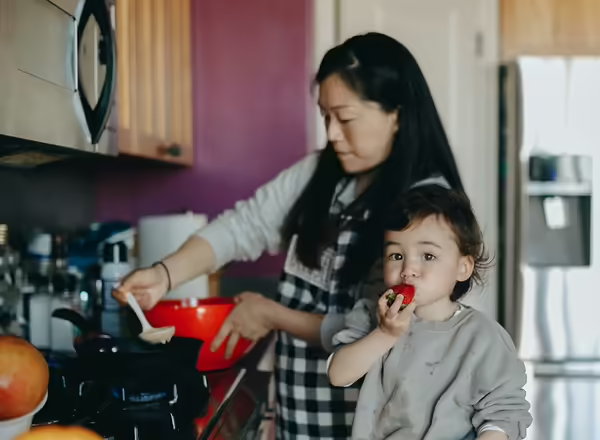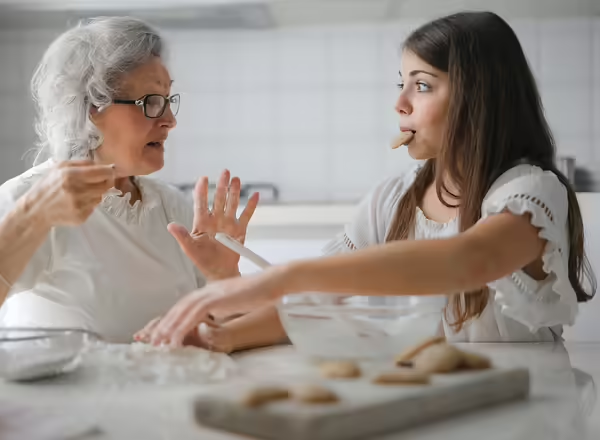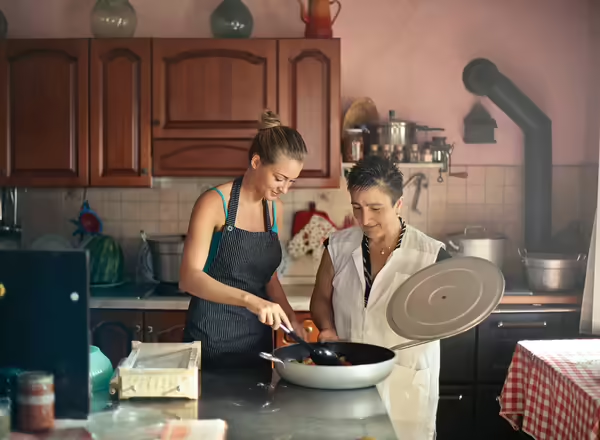
Kids in the Kitchen
Make cooking fun for the whole family!
Cooking with children is a great way to encourage trying new foods. They may learn to eat a variety of foods, which leads to a long-lasting healthy lifestyle. They also learn to develop important life skills at a young age, which will help them become independent later in life.
Kids involved in planning and preparing meals may:
- Be more willing to try new foods.
- Increase self-confidence by feeling like they are contributing to the family.
- Learn cultural and family traditions.
- Spend quality time with their parents or loved ones.
- Become exposed to a variety of healthy foods.
- Learn how to use all five of their senses.

Including children in the kitchen at a young age is a good way to teach proper hygiene and food safety.
- Teach handwashing skills: wash for at least 20 seconds with soap and warm water.
- Show children why it is important to separate raw and cooked foods, in order to avoid cross-contamination, or spreading germs from raw to cooked food.
- Use oven mitts or potholders when handling hot pans and dishes. Never leave the stove unattended while cooking.
- Cook food to the correct temperature before eating to prevent anyone from getting sick.
- Use a food thermometer and show them when the food has reached a safe temperature.
- Have children help clean up the dishes and wipe the counters to learn how to clean and sanitize correctly.
Assign kitchen tasks based on the child’s developmental level. Each child is different and may not fit into these suggested age ranges. Some skills may need to be adjusted until the child is safely able to complete them.

Kitchen activities for this age range focus on fine motor skills, abilities using hands, and following simple directions. With this specific age range, there is a wide variety of skill levels, so activities may vary.
- Use measuring spoons
- Wash fresh produce
- Spread butter or icing
- Mix ingredients with a spoon or their hands
- Roll, shape, and cut dough
- Dip foods
- Carry unbreakable items and ingredients from one place to another
- Pour liquids

Children can start to try more difficult cooking techniques and kitchen equipment. If using scissors or sharp knives, consider their skill level first.
- Crack eggs
- Clean and sanitize counters
- Mash soft foods, such as fruits, hard-boiled eggs, and vegetables
- Juice fruits
- Measure dry ingredients
- Cut using a small knife
- Make sure they have their hand in the proper form to keep their fingertips from getting injured
- Beat cake batter and fold in egg whites
- Peel oranges

Kids this age require less supervision but are not completely on their own. Consider giving them more freedom in planning meals and completing simple recipes without help.
- Use a vegetable peeler
- Whisk with a handheld mixer or whisk
- Open cans
- Read recipe directions and complete the steps
- Plan a meal for the family

This age group has the opportunity to have more freedom in the kitchen to prepare complex recipes, as well as being able to make changes to a recipe if they feel confident. Supervision is required in order to make sure they are being safe and practicing proper sanitation.
- Understand what certain kitchen equipment is and know how to work it
- Follow instructions
- Work on time and patience
- Understand the basic science of cooking
- What happens when I apply heat/cold to this food?
- Identify and pair different textures and flavors
References
- Kids in the Kitchen, Clemson Cooperative Extension
- Involve Kids in Planning and Preparing Meals, Canada's Food Guide
- Cooking with Kids Handout, University of Arkansas Division of Agriculture Research & Extension
- Cooking with Kids in the School Garden, Rutgers Cooperative Extension